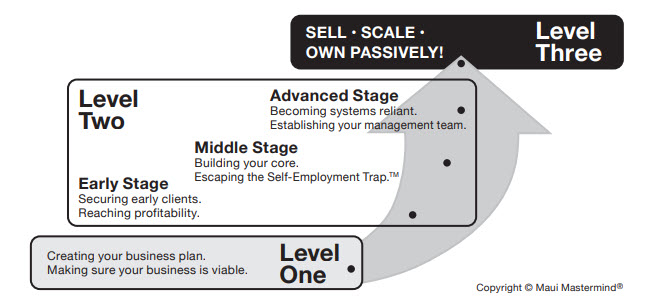The Definitive Guide to Scaling Your Business
How To Grow Your Business Without Sacrificing Your Life
A step-by-step guide for business owners that want to experience true growth and time freedom.
From Priceline.com founder Jeff Hoffman and Maui Mastermind CEO David Finkel.
| The information contained is this guide comes from over 20 years of experience building and selling businesses. It will benefit you to stay alert, take notes, and follow the action steps. When applied, these proven principals will change your life and give you time freedom, financial freedom, and piece of mind. |
Day 1: Understand Your Destination
Welcome to The Definitive Guide To Scaling Your Business.
This is a no-nonsense guide for how to grow your business the right way–without sacrificing your life in the process.
We purposely cut out the fluff and added action steps so you could apply this information right away.
It is divided into 7 days, but you can also go through it faster if you choose.
If you have any questions please feel free to contact us at 1-866-214-6619 or email at [email protected].
Now let’s get into it…
$100 Million In The Bank
We asked Jim, a successful business owner in Chicago, what he would do differently if he could go back to when he was first struggling to grow his business. We also asked how he would build the business if he started with $100 million in the bank.
His answer might surprise you:
“I would pay someone to mentor me.
Getting mentored or coached by someone that has done it before you and has insider knowledge is the fastest path to success. For example, if you wanted to learn how to play Tennis professionally, what would be the fastest path to get there? Obviously hiring a mentor or coach would be the fastest and maybe the only way to get there. And the more access you had with the coach, the faster your results would be.
It seems so obvious to me now. Not only can a mentor or coach provide you with tools and techniques to shortcut your success, but they can hold you accountable, help you organize your thoughts, and provide feedback and support as you grow.
The bottom line is that the more access you have to a mentor or coach, the faster you will reach your goals.”
Great answer Jim. We agree. A coach will significantly accelerate your success which is why its the secret ingredient for so many successful people. But you don’t need $100 million in the bank to get access to a coach and mentor for scaling your business. We are right here, and we have created this comprehensive guide to help shortcut your path for scaling your business and experiencing true time freedom.
The question is: Are you the type of person that can be committed to getting the help you need and following the steps of business owners that have done it many times before you?
Who are we?
Jeff Hoffman has started numerous companies and is Co-Founder of Priceline.com. He is a successful entrepreneur, proven CEO, worldwide motivational speaker, Hollywood film producer and producer of a Grammy winning jazz album. Jeff co-authored, with Maui CEO David Finkel, SCALE: 7 Proven Principles to Grow Your Business and Get Your Life Back. Jeff is a featured business expert seen on Fox News, Fox Business, CNN, CNN International, Bloomberg News, CNBC, ABC and NPR, and in publications including Forbes, Inc., Time, Fast Company and the Wall Street Journal. |
What Is A Level 3 Business?
First off, what is the ultimate goal for a business owner?
It is to build a company that he or she can one day sell, continue to scale, or own passively.
And, what gets in the way of this?
Most business owners reach for growth by working harder and personally trying to produce more. This is a flawed model that at best will lead to only moderate growth. At worst, this strategy can literally put your entire company at risk.
So, what can we do to reach the ultimate goal?
Use the Level Three Roadmap, a comprehensive model for building and scaling your business.
Ok, but what is the Level Three Roadmap?

The Level Three Roadmap is the defined pathway through the complete life cycle of your business from launch to exit.
Essentially the Level Three Roadmap will help you go from a Level One business (a start‑up), through Level Two (an owner-reliant company), to Level Three (a rapid growth or “exit stage” company).
Scaling your company and reaching the ambitious goals that you really want requires that you move beyond an “owner-reliant” business to one that is systems driven, with a solid management team and intelligent business controls in place—a Level Three business.
Remember, the finish line is not to just be profitable; the real finish line is to build a truly scalable business that creates massive value in the marketplace without needing you to be there every day to run it.
Our goal is to get you and your business to Level Three.
Now let’s figure out your current level and what you need to do to get to Level 3.
How Do You Get To Level 3?
First, go through the levels below to find out your current level. Then see what you need to do to reach the next level. Don’t worry about implementation at this point. We will get into that in the days that follow.
Level One: Pre-Launch Start-Up
Focus: Planning your business, raising capital, and getting initial market feedback to see if it’s viable.
You’re still working on your business plan, raising your start-up funding, and preparing to launch your new business
How to get to the next level:
Launch! Start actively marketing and selling your products and services.
Next Level ►►►
Level Two – Early Stage: Post-Launch Start-Up
Focus: Making those early sales and learning to produce and fulfill on its core product or service so that the business reaches profitability.
Your business is in its infancy, scrambling to make those early sales and fulfill customer promises.
This is the time to learn your business and market, and if needed, discover and fix any fatal flaws in your business model or how your targeted customers perceive the value you’re creating. Your early focus while launching a business isn’t on building the perfect product or service, but rather on figuring out how you can get people to buy. Too many entrepreneurs get caught in the trap of making the perfect widget, but never actually sell enough of that widget to ensure a profit. Of course you need to deliver on your promises, but you can iterate and improve your product or service as you go. Without sales, you have no business. At this stage, you’ll be wearing just about every hat in the business. That’s OK for now, but as you move toward Middle Stage Level Two, you’ll need to find ways to leverage your personal production for the business by hiring staff and building the basic business systems and controls you need. An Early Stage Level Two business is working to generate sales, establish a market position, and become a sustainable business.
How to get to the next level:
Once your business is profitable and you are confident that is going to survive move to Level Two – Middle Stage.
Next Level ►►►
Level Two – Middle Stage: The Owner-Reliant Business
Focus: Stabilizing your core and beginning to remove “you” from the center of the business.
Your business is sustainable, but only if you’re present to work for it. You’re the main producer and director around whom your company revolves.
Once your business is profitable and you are confident that it is going to survive, it is time to build your business’s four core systems: 1. Lead Generation: your system for finding prospects. 2. Lead Conversion: your system for closing sales. 3. Production and Delivery: your system for producing and fulfilling your core product or service. 4. Collections: your system for collecting on what you are owed. These four systems—for finding leads, closing sales, producing your product or service, and collecting on your receivables— are the four core systems of every business.
How to get to next level:
Middle Stage Level Two requires building your core systems, team, and controls, while balancing your business’s need for you to continue to lead its daily operation. This is a delicate balance between operating the business in the here and now, and building the structure you’ll need to grow beyond your current situation. Once you have established your solid base, you’ll progress to Advanced Stage.
Next Level ►►►
Level Two – Advanced Stage: The Rapid-Growth Company
Focus: Scaling your business in earnest.
Advanced Stage Level Two: Your business is growing fast, with employee leaders in two or more of your five core pillars (Sales/ Marketing, Operations, Finance, Team, and Executive Leadership). You’re in the process of refining your business systems and building your management team.
At Advanced Stage Level Two, you’ll begin the important work of refining your systems, building your management team, and scaling your business in earnest. This is the “Rapid Growth” stage of your business. In this stage you’ll also begin to build out the auxiliary systems you need in other parts of your company, from hiring to training to marketing to managing and more. You’ll see that your revenue is exploding and often you’ll feel like your business is bursting at the seams as you struggle to keep up with the growth. A key shift at this stage is to enroll your team in building the systems, controls, and scalable solutions your business needs alongside you. Where a Middle Stage Level Two business owner commonly sees her team as a way to leverage her own personal production, an Advanced Stage Level Two business owner sees her team as partners in taking the business to the next level. This essential shift is what allows businesses to successfully make the leap to Level Three.
How to get to next level:
Build your systems, team, and internal controls to the point where the business runs independently of you.
Next Level ►►►
Level Three: The Exit-Stage Company
Focus: Choosing and executing on your “exit strategy”—to sell, scale, or own passively.
Level Three: Your business is firing on all cylinders with employee leaders in at least four of your five core pillars. Your business is systems-reliant and ready for you to choose your exit strategy—to sell, scale, or own passively.
A Level Three business is systems reliant, with a winning management team in place, and strong internal controls that allow the business to run smoothly and effectively independent of any one person. At this point, you truly have built a business, not a self-employed job. The business runs smoothly and your clients look to the business, not the owner, to fulfill on its promises. Now it is time to determine and execute your exit strategy. This may or may not mean actually selling your business. In fact, many Level Three business owners choose to stay actively engaged. What’s the critical distinction? Continued involvement is a personal choice, not a business requirement. You get to make that decision and choose any of these three main exit strategies: 1. You can sell the business and move on to your next great adventure. 2. You can scale the business to the big time. 3. You can passively own the business, with a greatly diminished role for yourself in its daily operation, generally fewer than five hours a week.
Why Do Most Of Us Get Stuck On Level Two?
Most businesses get stuck in Middle Stage Level Two.
Why?
Because the owners build their businesses for control based primarily on their personal production.
They are the ones who make the key decisions, close the big sales, and manage much of the day-to-day operations. Sadly, these typical Middle Stage Level Two business owners stay stuck at the tactical level of doing the job of the business instead of creating the time and space to step back and build the business as a business.
The painful reality is that most Level Two business owners get caught in the Self-Employment Trap.
They’re so busy doing the “job” of their business that they can’t step back and focus on growing their business. What’s more, because of the way they are building their business, the more success they have, the more trapped they become inside their company.
How Do You Get Out Of The Self-Employment Trap?
Bottom Line: You’ve got to work less and get your business to produce more.
Remember, the more you do, the more you have to keep doing. The more you get your business to do, the more time you have to grow and build your business.
This means building your business with the end in mind, the end being the day when it is no longer reliant on you the owner.
We call this type of business a Level Three business. This is our destination.
Action Steps – What To Do Now:
|


